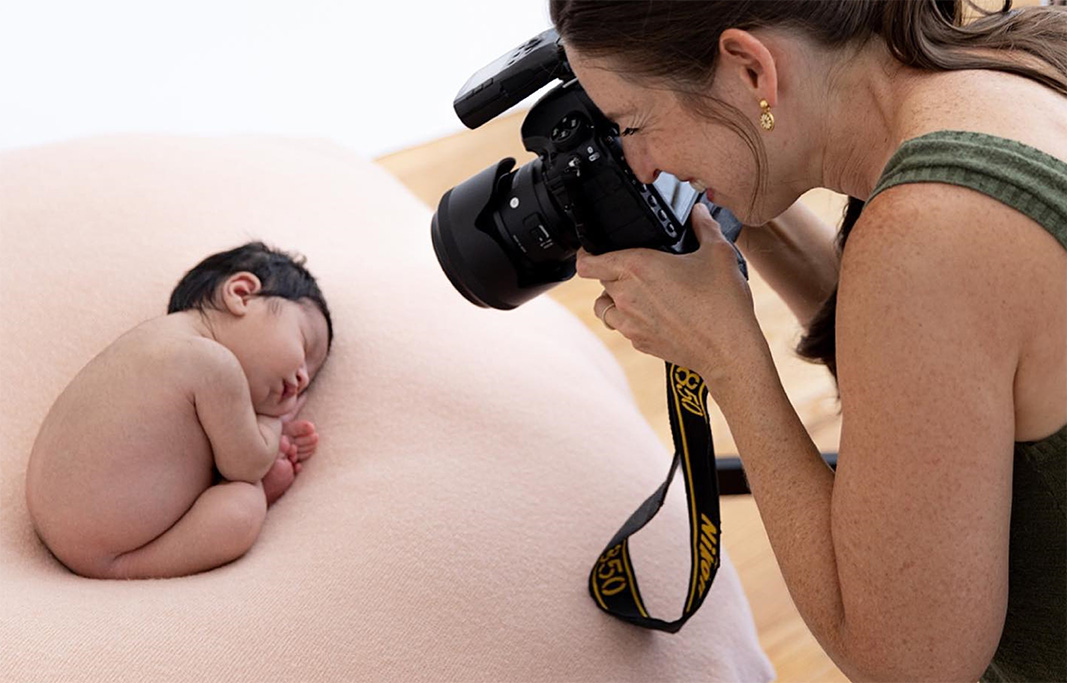The use of smartphones in photography indeed, raises very significant questions and concerns both among aspiring and professional newborn photographers:
Are smartphones going to replace professional cameras?
If I were to start a newborn photography business, would it provide value nowadays?
Can I still make a profit from professional newborn photography?
As an experienced photographer, this is what I tell them: although smartphones have truly made photography skills accessible and achievable to be learned by everyone, the demand for high-quality, professional photography work remains strong.
So if you are aiming to start a newborn photography business, I am happy to support you. I’ve put together 10 actionable tips to help you build the foundation for a successful newborn photography business.

Market Research
As a photographer myself, the first step I made to start my photography business was to conduct market research. Market research will help you aim for the right customers and be knowledgeable about your competitors within your local area. So how do you do this?
A: First, start with the people around you
There are no better people to vouch for your skills than the people you know. Take advantage of the relationships you have. You must know some friends, family members, or neighbors who are expecting to have a new baby in their families or have small children.
B: Second, analyze consumer profiles and behavior
Ineffective market research, you need to be very specific. By specifying your target customers, you can make the scope of your research more manageable and thus, will give you better results. Also, the more specific and detailed your research target group is, the easier for you to take advantage of their needs and develop strategies to convert them. Target customers who have the ability and enough motivation to get your services. You can also go to social media network groups or communities interested in newborn photography so you can learn more about the needs and desires of your target customers.
Let’s try analyzing the profiles and behavior of new parents who potentially want to have newborn photoshoots in Florida, USA:
a – Demographics When looking at the demographics, you can consider new parents who are typically aged between 25 – 40 years old and are residing in urban or suburban areas of Florida.
b – Psychographics Consider new parents who love to capture precious moments; they, for sure, would also want to keep memories of their newborns. These types of parents will value moments captured in high-quality photography that they can cherish for a lifetime.
c – Needs and Preferences New parents would want to seek professional newborn photographers with a studio that is capable of offering safe and comfortable environments for their babies during photoshoots. d – Behaviors:
– Online Researching. Expectant parents who are interested in getting newborn photography services would often conduct online research to look for them within their area. They may visit photography websites, browse social media platforms, and read reviews before making a decision.
– Referrals: Word-of-mouth significantly influences the choices of new parents. They will consider first recommendations from family, friends, and/or parenting communities.
– Booking Decision: New parents will prioritize convenience and flexibility when booking photoshoot sessions. They may prefer newborn photographers who offer options to book online and with flexible scheduling to accommodate their lifestyles.
By analyzing your potential customers in this manner as a professional newborn photographer, you can tailor your services and marketing strategies effectively. You can meet the needs and preferences of new parents who are seeking newborn photography services in your state.
C: Lastly, Research Your Competitors
To add to your potential customer research, you should also learn who your competitors are. You have to know their strengths and weaknesses and observe them to avoid the mistakes they make. Here’s an important note when doing market research; you need to avoid the following mistakes:
Only using secondary market research. Don’t depend on collecting information only from pre-existing sources. You should also conduct research from scratch.
Only using online documents. These do not necessarily provide the information you need in looking for specific customers in your area.
Only surveying people you know. Do not limit your research to only those people you already know. Expand your search by meeting and asking other people in your surrounding area.

Make a Business Plan
You can have one or more great ideas for your business but turning that idea into a sustainable business is an entirely different story. Before you start the process of establishing your newborn photography business, you need a business plan from A to Z. You should seriously do this task if you want a long-term entrepreneurial path and avoid future risks.
Business plans play a very important role for startup businesses as this includes your business process, orientation, strategy, and goals of your business for a certain period. This plan is built based on the information you have about your market, competitors, customers, and the business direction you want to implement. You will also be able to define your marketing plans and activities, look closely at your financial condition, and the human resources that you need, and most especially, you’d be able to anticipate the risks that you may encounter while doing the business.
To start, you can apply the following steps in creating a business plan:
1. Define your vision
2. Set specific goals
3. Identify your unique selling point (USP)
4. Research your competitors
5. Conduct market research
6. Learn the relationship between supply and demand
7. Plan your budget
8. Start your plan
Prepare Financial Resources for Your Business
When asked for advice by my friends in other states on what to prepare when starting up a newborn photography business, I begin by being honest about the expenses. There are what you call fixed costs, and you can’t ignore these when opening a studio. These costs depend on the business model and the business goals:
1. Background Costs. You have to prepare different backgrounds/backdrop designs that will fit the themes your customers want.
2. Shooting Lights. When taking photos in a studio, good lighting is required. You’ll need at least 2 flashlights and in addition, use the support of 600, 900, or 1200 LED lights.
3. Camera Equipment. No shots without the camera. This will usually depend on the quality of the camera you want to use.
4. Printing Costs. You need to print the photographs so they can be framed and displayed.
5. Other Costs. Costs of purchasing computers, storage devices, management software, etc.
At the same time, there is another set of costs to consider. These are the costs incurred or the costs that are spent for the problems or operational needs that may arise. These may include maintenance costs, repair costs for mechanical equipment, photography equipment, etc. Therefore, I advise that you should set up a reserve fund for possible emergencies and incidents.
The reserve fund may not be too much, just enough to be able to resolve emergencies immediately depending on your economic situation. Note that this is a precautionary fund for possible risks, so you should set it up right from the start of opening a photography studio.

Legalize Your Business
You need to pay attention to the legal aspects of the business early. This will help you not to worry about anyone stealing your ideas or sabotaging your partnerships. Here’s a checklist of what you need to fix to legalize your business:
– Business structure (Sole Proprietor, Company, Partnership, etc.)
– Business name
– Business Registration
– Tax Code
– Business License
– Bank Account/s
– Trademarks, Copyrights, or Patents.
You should also need to prepare a draft or a template of your contracts.
The contract will set expectations in addition to facilitating efficient operations related to your business. Your contract template should, at the very least, include the following:
1. Portrait Contract/Model Release. A portrait contract is an agreement that outlines the terms and conditions between you, the photographer, and the client. It will be signed by the parents or legal guardians. A model release will permit the photographer to publish the images of underage kids, parents, siblings, or other members included in the photo.
2. Final Sales Agreement. The total cost that the client will pay is outlined in this section of the contract. This will be signed on the day of the photoshoot session. This is to guarantee that the client cannot change their mind and refuse to pay for the services given. This part of the contract also waives any ‘cooling-off’ legislation that may exist in your state/location.
3. Album/Artwork Design Agreement. Creating albums or artwork for your customers can cost you hundreds of dollars. This section of the contract must state the client’s approval and agreement to purchase this work from you and is indicated by their signature.
4. Delivery Agreement. When the client receives the finished album or artwork, they will sign this. It will be stated in this contract that every commissioned work has been received and delivered according to expectations.
While some of these agreements can be done on your own, it is always best to consult with a lawyer when getting started. This will ensure that you will not miss any legal needs for your business and between your clients.
Prepare Facilities: Studio, Equipment, and Props
A – Securing a Studio
As mentioned, it is crucial to prepare enough budget to be able to pay for your fixed costs as these are necessary to run your photography business. However, this does not mean that you don’t have a choice for cheaper options. To avoid paying rent for a dedicated studio space, you can opt to turn a small option of your home into an in-home studio. This will not only save money but also your time to commute to work. And if you happen to offer lifestyle newborn photography, you won’t need a studio space because you will be doing the shoot in the new family’s own home.
When starting your business, money will be tight. Therefore, only purchase the necessary equipment!
B – Purchasing Photography Equipment
Photography equipment can cost from hundreds to thousands of dollars. You will need to do your research before buying one so you won’t make a costly error. Aside from your camera, you will also need to buy photography gear, subscribe to editing software, and other additional equipment to make your job easier for you.
C – Invest in Buying Props
You need your newborn photos to be magical and such needs props to get it done. Props can be also expensive so plan out what themes would you usually use when doing the photoshoot. It is ideal to start with simple props and gradually add more to your collections as your revenue and skill increase. Here’s a sample list of props you should consider to invest in:
– Beanbags
– Throw pillows
– Hats
– Headbands
– Blankets
– Baby-safe trinkets and accessories
IMPORTANT!
When buying your props, always consider that they are baby-safe–your props should in no way be able to hurt the baby.
Safety first. Props should be free from sharp edges, and should not have any small detachable parts, or anything that can potentially hurt the baby. Also, buy some backdrop stands and clamps to support your equipment to avoid the risks of any accidents.
Check Material Quality. The material for your props should be non-toxic and hypoallergenic. The fabrics should also be soft and breathable.
Clean Everything. Make sure that you properly clean and sanitize your props before using them.
Regulate the Temperature. Newborns cannot regulate their body temperature well. Invest in a space heater to make your studio comfortable for the newborn.
Don’t Startle the Baby. Babies are easily startled and your camera’s shutter sound may cause it. Invest in audio equipment that emits white noise.

Focus on Your Marketing Strategy
Now, when almost everything is prepared–you already have a target market, a studio, and the necessary equipment, it’s time to face the challenge of creating a marketing strategy. How can you capture your target market and convert them into clients? Here are some ways:
A – Offline Marketing
1. Local Networking. Attend local events where many parents are present, baby expos, community gatherings, and other events where you can network with expectant parents. Partner with maternity clinics, pediatricians, and boutiques that sell baby necessities. Display your work and offer exclusive promotions to their clients.
2. Word-of-mouth Referrals. Encourage your clients to refer your services to their friends and family members. You can also offer referral discounts and incentives. Providing excellent customer service as well as delivering high-quality results to ensure positive impressions and recommendations.
3. Attending/Organizing Events and Workshops. You can host newborn photography workshops to increase your visibility and showcase your expertise to expectant parents. You can also sponsor or participate in charity events and fundraisers within your community to raise brand awareness and support local causes.
By doing these offline marketing strategies effectively, you’ll surely build lasting relationships with your clients and you can become a trusted name in the newborn photography industry.
B – Online Marketing
1. Have your professional website. Showcase your portfolio by having a website of your own. You can add here your work, services, pricing packages, and client testimonials. Through your website, you can also have an online booking system so that it is easy for your potential clients to schedule sessions. Your website will also make you easier to reach since your clients can place their inquiries and you can respond to them fast and easily.
2. Be present in various social media channels. Create accounts on popular social media platforms under your studio name. Showcase your work on Instagram, Facebook, and Pinterest, and engage with potential clients then build a community of followers. You should regularly post your work, BTS content, and most especially, your client testimonials to showcase your expertise and attract new clients.
3. Try paid advertising. To reach a much larger audience in a faster way, you should invest in targeted digital advertising campaigns through social media accounts and search engines. Then make use of retargeting ads to re-engage with website visitors who have shown interest but have not yet booked a session.
4. Content Marketing. Through your website, write blog content that can share informative articles, photography tips, client stories, case studies, and any other content that can showcase your expertise in newborn photography. Create engaging video content and post behind-the-scenes footage on YouTube, TikTok, and other social media platforms.
5. Email Marketing. Build an email list of your potential clients and past customers. Make use of this list to send them regular newsletters with updates regarding your services, new discounts, promotions, and upcoming events. You should personalize your emails based on your client’s interests and preferences to increase engagement and conversion rates.
6. Online Reviews and Testimonials. Urge your customers to give you a favorable evaluation of your services on your website. You should also be prompt to respond to any negative reviews and feedback and take proactive steps to address client concerns and improve their experience.
Having both offline and online marketing strategies will keep you in a competitive lane. Remember to always network, interact, and improve to capture valuable customers for your newborn photography business.

Create Pricing Packages
Strategizing your pricing is a critical aspect of running a newborn photography business. It can be a daunting and challenging task for newcomers in the field since you need to balance your worth and the amount that clients are willing to pay. Your pricing plan is a huge factor in making sure of your business’ sustainability and growth. Here are some tips to help you create the right pricing strategy:
1. Do a cost analysis
Make a list of every expense you incur–software subscriptions, gear purchases, insurance payments, transportation fees, and the time required for you to edit each newborn photo. Establishing a baseline for your service price requires a good understanding of your overhead costs.
2. Research Your Competitors’ Pricing
Investigate your competitors’ pricing strategy. This will help you position your pricing competitively while at the same time, covering your costs and targeted profit margin. This will also give you an idea of the average market rate of photographers with similar skills and experience as you.
3. Create Service Packages
Create various packages for your baby photo services–offering differing requirements and financial constraints. You can indicate the number of photos, photoshoot duration, the kinds of products that the clients will receive (digital files, albums, prints, etc.), and any other type of services you can provide. You just have to make sure that the costs and intended profit margin are reasonable for each package.
4. Offer Value-Added Services
Consider offering value-added services such as home photo sessions, a series of photoshoots from pregnancy to childbirth and until the baby is born, photo albums, or prints as part of your packages. These can help boost your potential revenue. When setting your price for your services, remember to account for all other production-related expenses.
5. Re-evaluate Regularly
You should adjust your pricing plans as you gain more knowledge, skill, and recognition in your business and as a photographer. Review and modify them regularly based on the demand for your services, your market, and your perceived value. As you gain a better reputation over time, strive to raise your rates, you deserve it.
Always remember that striking the correct price balance is essential. Never underprice your services because it will diminish your value and will make it difficult for you to maintain a profitable business. At the same time, overcharging could turn away potential customers, especially if you are still in the early stages of developing your brand.
Optimize Costs by Developing Outsourcing Services
As you hone your photography skills and master the art of capturing moments of newborn babies, you need to also make time to learn new ways to optimize your costs. One of the effective strategies is to offer outsourcing services. Outsourcing services may include image editing or media publication design. Offering these can significantly reduce your operational expenses while still making sure that you maintain high-quality results.
– Image Editing Services
Surely, you already have expertise in editing images, and such a skill can generate additional income. Offer monthly photo editing packages tailored to photographers’ needs. You can also present some editing styles to ensure that the final images align with their preferences.
– Media Publication Design Services
Moreover, you can also offer media publication design services and hire highly skilled designers who can offer professional design expertise at a fraction of the cost offered by in-house design teams. Through these outsourcing services, you can streamline your newborn photography business operations, reduce overhead expenses, and focus on core activities such as providing better customer service and photoshoots.

Establish a Workflow
Streamlining your work process is essential for a smooth-running business. Establish a workflow that you can easily follow so you can be more effective in time management and be more efficient at your job that satisfies your clients.
Along the process of developing your business, you’ll discover that there will be more steps to take. You must optimize them often and improve them to bring satisfaction. Let me share with you my working process as an experienced newborn photographer for 10 years:
Step 1: Gather Client Information. Receive inquiries from customers and gather their information. If you are using a project management platform, add the details to your database.
Step 2: Establish Good Communication with Your Clients. Respond promptly if your clients have inquiries and address their questions and concerns accordingly. Establish clear communication channels for easy correspondence with your clients.
Step 3: Create a Contract. Prepare a contract outlining the terms and conditions of the project. Ensure that all necessary legal and payment details are also included in it.
Step 4: Contract Execution. Send the contract to the client for review and signature. Once signed, co-sign the contract to finalize your agreement for the project.
Step 5: Deposit Processing. Send an invoice so that your client can deposit the amount necessary to start the project as agreed. Upon receiving the deposit, mark it as received and confirmed.
Step 6: Schedule the Session. Coordinate with the client to finalize the schedule of the photography session as well as the location of the shoot. Make sure to conduct any necessary scouting of the location beforehand if it’s outside your studio.
Step 7: Photography Session. Make sure that the photography session is conducted on the agreed schedule. Create a checklist and prepare all necessary equipment and resources that are needed for the shoot.
Step 8: Create a Backup. Remember to have a storage device to back up all the images you captured to prevent data loss.
Step 9. Post Processing, Editing, and Finalization. For post-processing, you can use software like Aftershoot for efficient image culling and editing. Perform the first pass of edits on selected images, focusing on basic adjustments. After that, create a second pass for final tweaks and enhancements to ensure the quality of the images.
Step 10. Export and Backup. Export the edited images in the desired format for delivery to the client. Make sure to back up the edited files to prevent loss or data corruption.
Step 11. Delivery. Upload the finalized images into a secure online gallery or a cloud storage platform. Notify the client of the completed project and provide access to the image gallery.
Step 12. Final Payment and Closure. Send the final invoice to the client for the payment of the remaining balance. Upon receiving the payment, mark the project as completed and archived.
You can copy and implement this structured workflow to streamline your newborn photography projects. This workflow has so far earned satisfied clients and has improved the overall efficiency of the business process.
Get Feedback
Receiving an objective review can help point out problems or issues you may have missed. Getting some advice could be very helpful to improve the way you manage and execute your photography sessions. Therefore, you should learn how to get and manage feedback from your clients.
In my 10 years of experience, these are the tips I can share in handling feedback from my clients:
Tip #1. Upon receiving the feedback, pause to carefully consider them. Reflect on the feedback you received before reacting or making any decisions. This will allow you to make a more rational and constructive response, ensuring that the feedback is clearly understood and considered in your next decision-making process.
Tip #2. Express gratitude for both positive and negative feedback. Always demonstrate humility, openness, and willingness to receive input from others. Expressing gratitude for both positive and negative feedback cultivates a culture of appreciation and openness.
Tip #3. Remember that criticisms don’t necessarily mean overall rejection.
Tip #4. Identify recurring feedback. If issues from your clients arise repeatedly, you need to analyze them and find out why these instances happen. This way, you can find out the strengths and weaknesses of your business in improve.
Tip #5. Ask questions to understand feedback better and seek improvement opportunities. Once a month, do a customer survey to get feedback from other people and/or clients. You can clarify ambiguous feedback, uncover the root causes of issues, and identify specific actions or changes that can improve services in the newborn photography business.
Receiving negative feedback can be difficult. The best advice I can give is to write or list down all the positive feedback you received. By reading them from time to time, you’ll be inspired to continue working and disregard the hurt of receiving negative criticisms. At the same time, it will be a great way to also promote your services.
Although there are still plenty of other things that you can do to develop your company, these 10 tips can help launch your newborn photography venture and set you up for success.
To recap, position yourself in the industry by identifying your target market, developing a portfolio, finding a specialty, legalizing your business, and most importantly, honing your skills. Create a business and marketing plan. By doing the hard tasks at first, you will be saved from unpleasant surprises and will position yourself for success.
Don’t decrease your value by charging too little, but at the same time never overcharge your clients. By establishing a workflow, you can assess the scope of your job and provide your clients with consistent and satisfying experiences. Lastly, whether you are turning this passion of taking photos of newborns into a part-time side hustle or into a full-time career, with these 10 tips, you will surely have a successful, booming business!




